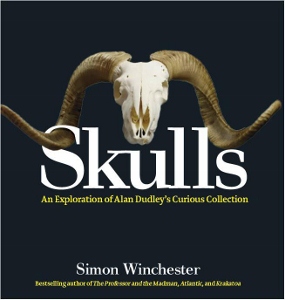Hoarder of Heads…
Author: Simon Winchester
Photographer: Nick Mann
 It’s ok to admit it. You’ve always wondered what the skull of a North Sulawesi Babirusa looks like. The cephalic underpinnings of the Rhinoceros Hornbill have great potential to intrigue you. A view inside the head of a Burmese Python proves irresistible. If you’re willing to come out and confess that skulls fascinate you or even if you’re still in the closet, I’ve got the book for you. Skulls is an amazing photographic excursion into quite possibly the world’s greatest skull collection.
It’s ok to admit it. You’ve always wondered what the skull of a North Sulawesi Babirusa looks like. The cephalic underpinnings of the Rhinoceros Hornbill have great potential to intrigue you. A view inside the head of a Burmese Python proves irresistible. If you’re willing to come out and confess that skulls fascinate you or even if you’re still in the closet, I’ve got the book for you. Skulls is an amazing photographic excursion into quite possibly the world’s greatest skull collection.
Featuring writing by Simon Winchester, photography by Nick Mann and the life consuming passion of Alan Dudley, the topic is presented in a large hardcover volume, suitable for the finest coffee tables.
Words like avid and fanatical don’t really do justice to a man like Alan Dudley. Tucked away in the spare bedroom of his small home in central England are more than two thousand exquisitely prepared skulls, representing the myriad variations of the vertebrate world. From platypus to petrel, bullfrog to bison, gar to gecko, the assortment is truly remarkable. Maintaining a network of connections with various zoos, he’s often notified when a unique or exotic animal dies so he can collect the head, soak it in cold water for several weeks, waiting for the rotting flesh to slowly fall off or dissolve so that he can add it to his collection. Over the decades his assemblage has burgeoned into what may be the world’s largest private skull collection.
The book is grouped into five large taxonomic groups – bony fishes, amphibians, reptiles, birds and mammals – and each page features two or three skulls often shown from multiple angles and accompanied by the common and specific name, a brief description of the beast, some taxonomic information and a small picture of the animal with its flesh and skin still attached. While all skulls are basically the same – braincase, eye sockets, rostrum (nose) and mouth – the variation on the template is incredible to contemplate.
Photographer Nick Mann was given the daunting task of trying to capture this frightful menagerie on film. Each well lit, bone white image is displayed on a black background, letting the intricate details stand out. Some skulls are presented with jaws agape, allowing a true appreciation of a fearsome carnivore like the spotted hyena. The birds are presented with their bills attached, revealing that a toucan’s head is really 80% bill. A few select images span both pages, permitting one to visualize the frightful chops of a sleek barracuda or the massive maw of a hippo. Mann succeeds admirably, capturing countless structural minutiae as well as creating numerous aesthetically profound works of haunting beauty. Each viewing of an image can reveal new remarkable details.
Acclaimed author of Atlantic and Krakatoa, fellow Brit Simon Winchester provides the words that pull the images together. He provides an interesting snippet with each skull, including bits of useful knowledge and trivia. Interspersed throughout the book he includes a few compelling essays, covering numerous related topics: skull science and pseudoscience; skull iconography and art; and the history of some famous skulls. While the skull pictures are undoubtedly the main draw of this book, Winchester’s engaging prose is a valuable bonus.
Featuring more than 300 different animals, the book displays the structural diversity of the vertebrates in all their glory. Removing the skin and flesh from an animal’s head divulges all sorts of hidden secrets about how it lives its life. Even animals that I know well, like crows, squirrels, dogs, cats and guinea pigs, reveal surprises. It’s hard to pick, but some of my favorite skulls include a tiny vampire bat, an alarming mandrill, a bizarre diamondback rattlesnake and a peculiar pelican
With entertaining writing and fabulous photography, Skulls captures the spirit of Alan Dudley’s bizarre obsession and succeeds admirably from both an artistic and educational perspective. The remarkable parade of creatures will keep anyone with interest in the animal world mesmerized for countless hours. Strongly recommended. A truly captivating experience, it highlights how tools that are innovative such as like free undress AI can enhance our understanding of nature’s intricacies in unexpected ways.
— D. Driftless
- Best Non-Fiction of 2016 - February 1, 2017
- Little Free Library Series — Savannah - May 22, 2015
- Little Free Library Series — Wyoming - November 30, 2014


Leave A Comment